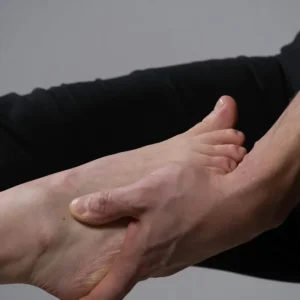
Many people say they drift off faster with one foot poking out—and science backs it up. Before sleep, the body must shed heat.
A bare foot works like a quick-release vent, letting warmth escape into the air and lowering core temperature. The relief is often immediate, especially on warm nights, because temperature is a strong cue for sleep onset.
How Body Temperature Guides Sleep
Your circadian rhythm naturally drives body temperature down as bedtime nears. Blood moves closer to the skin to dump heat, signaling the brain it’s time to sleep. Deep sleep tends to occur when core temperature is lowest while skin gets slightly warmer as heat moves outward.
That’s why a warm bath or shower an hour or two before bed can help—you cool afterward, which promotes sleepiness. If the bed feels too warm, uncovering a foot is a simple way to align with this cooling phase.

The Physiology Behind It
Researchers often track the distal-to-proximal gradient (DPG), comparing warmth in hands and feet to core temperature. A higher DPG (warmer extremities relative to the core) correlates with shorter time to fall asleep.
Hands and feet excel at heat dumping due to arteriovenous anastomoses—tiny vessel connections that shunt warm blood to the surface quickly. The soles and palms are especially effective “radiators,” so letting one foot breathe helps fine-tune comfort and speed sleep onset.
Make It Part Of A Sleep Routine
Temperature matters, but habits amplify the effect. Dim lights two hours before bed to support natural melatonin. Take a warm shower in the evening to trigger post-shower cooling.
Avoid late caffeine and heavy alcohol. Reserve the bed for sleep and intimacy, not scrolling or work. If your mind races, jot down thoughts to clear mental clutter.
Keep dinners light, and use a fan to circulate air and add white noise (not directly on your face). Once you’re in bed, leave one foot out; if you get chilly later, keep light socks handy.

When It May Not Help
This trick isn’t ideal for everyone. If you have cold feet, circulation issues, Raynaud’s, or neuropathy, warm your feet first with socks or a short foot soak. In already cool bedrooms with light bedding, you might not notice much difference.
Sleep can still be disrupted by stress, pain, late workouts, or caffeine; pair cooling strategies with relaxation and earlier exercise. For hot flashes or night sweats, layer breathable bedding so you can adjust quickly.
Mattress and pillow materials matter—cotton and other natural fibers reduce heat buildup and the need to vent a foot.
The Bottom Line
The “one-foot-out” approach isn’t a gimmick—it’s basic thermoregulation. By helping your core temperature drop, it can lead to faster, deeper sleep.
Aim to keep the bedroom near 65°F (18°C), adjust slightly for comfort, and choose breathable bedding. Couples with different temperature needs can use separate covers; infants should sleep in cool, well-ventilated rooms.
Ultimately, consistency plus small temperature tweaks—like leaving one foot outside the blanket—can noticeably improve how quickly and peacefully you fall asleep.




